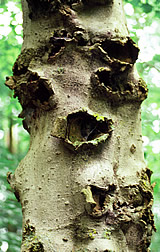This page has been archived and is being provided for reference purposes only. The page is no longer being updated, and therefore, links on the page may be invalid.
|
|
Thanks to Systematics, Battle Is on to Save a Great American Hardwood
By Erin PeabodySeptember 26, 2006
New England's famous fall colors just wouldn't be the same without the fiery coppers and reds of the American beech tree. Unfortunately, this key member of North America's eastern hardwood forests is slowly being eaten alive by a group of fungi that have, up to now, baffled and confused researchers.
Now, thanks to systematists with the Agricultural Research Service in Beltsville, Md., it's clear that two distinct fungi in the Neonectria genus should be targeted in the scramble to keep beech trees out of harm's way. Systematics is the study of how the world's myriad organisms are identified, described and classified.
Causing tree dieback and sometimes death, beech bark disease (BBD) has so far left its biggest scar on the nation's northeastern forests. Creeping southward along the spine of the Appalachian Mountains, the disease currently threatens to invade vast beech tree stands across parts of Pennsylvania and West Virginia.
Like genealogy experts mapping a family tree, ARS researchers Amy Rossman and Lisa Castlebury at the agency's Systematic Botany and Mycology Laboratory sorted out the murky relationships between the many Neonectria fungi that appeared linked to BBD.
They've now confirmed that two Neonectria species are of real concern. One is N. faginata, which may be native to North America. The other, N. ditissima, attacks multiple hardwoods, including fruit trees.
This information will be vital to researchers trying to breed trees resistant to BBD and to inspectors charged with preventing pathogenic fungi from entering the country.
If you're in the Washington, D.C., area and are interested in learning more about the many ways ARS systematists like Rossman and Castlebury have helped safeguard the nation's agriculture and natural resources, you're in luck!
An interactive exhibit, entitled "Systematics: Roots and Relationships," is now on display at the U.S. Botanic Garden (USBG) on the National Mall. It runs through October 16. See the USBG website at: www.usbg.gov for further information.
ARS is the U.S. Department of Agriculture's chief scientific research agency.

